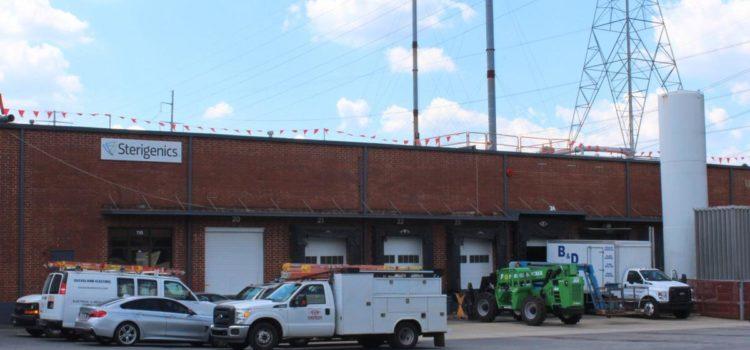
Caption
The Sterigenics plant in Smyrna could be subject to new regulations if an EPA proposal meets full approval.
Credit: File photo courtesy Georgia Health News
|Updated: April 14, 2023 4:50 PM

The Sterigenics plant in Smyrna could be subject to new regulations if an EPA proposal meets full approval.
The U.S. Environmental Protection Agency has proposed a new set of restrictions on facilities that use ethylene oxide, a carcinogenic chemical used in sterilizing medical devices.
The colorless, odorless gas also called ETO grabbed Georgians’ attention in 2019 when Georgia Health News and WebMD reported higher than average rates of cancer among residents near a Sterigenics plant in Smyrna and a BD Bard facility in Covington.
In a press call Tuesday, EPA officials said their proposal would cut emissions to the air from commercial sterilization facilities by 80% per year, decreasing to below the agency’s Clean Air Act benchmark for elevated cancer risk. The proposal also includes new measures intended to decrease risk for workers who use ETO or who work in other areas of the facilities.
The EPA says short-term exposure to the amount of ETO in the air around facilities is not likely to cause immediate health complications, but regular exposure over the course of years increases the risk of cancers affecting white blood cells and of breast cancer in women. Children may be more vulnerable to the ill effects of breathing in the chemical. It is unlikely to remain in food or water long enough to be eaten or swallowed, researchers say, and it is not known to be absorbed by soil.
A new EPA analysis estimates the additional lifetime cancer risk associated with continuous workplace exposure to ETO for eight hours a day, for 240 days per year, over a period of 35 years in an occupational setting is between 1 in 36 and 1 in 10 for workers who use ETO in sterilization facilities, and between 1 in 25 and 1 in 12 for workers who use it in healthcare facilities. These risks can be reduced by increasing access to personal protective equipment, adequate ventilation and safety protocols to avoid direct contact with ETO. Many facilities have already successfully implemented these measures, according to the EPA.
The proposal would require continuous air monitoring at the facilities and require the companies to submit data to the EPA twice a year to confirm emissions are being captured properly, said Tomás Carbonell, deputy assistant administrator for stationary sources in EPA’s Office Of Air and Radiation.
“These continuous emissions monitors are the most accurate type of monitoring for ethylene oxide emissions from commercial sterilizers,” Carbonell said. “We believe this proposal addresses the ethylene oxide emissions from sterilization facilities in a comprehensive way, ensuring facilities can meet stringent emissions requirements while also providing sterilized medical supplies that are vital to the medical supply chain.”
In 2020, Gov. Brian Kemp signed a bill requiring ETO spills to be reported to the state Department of Natural Resources.
The EPA is planning a public webinar May 1 at 8 p.m., and a 60-day public comment period is planned. If the proposal gets final approval, facilities would be required to install the new controls within 18 months.
“This is a more rapid pace than the two to three years that is specified in the Clean Air Act, and this will help deliver stronger health protections to communities as quickly as possible while still providing sufficient time for facilities to meet these emission requirements,” Carbonell said.
In statements to the Recorder, both Sterigenics and BD Bard touted their efforts to limit ETO exposure to their facilities’ surrounding communities.
BD Bard spokesman Troy Kirkpatrick said the company voluntarily installed new systems in their Covington and Madison facilities in 2020 that reduce residual emissions by 90% to 95%.
“Georgia EPD has collected more ambient air data regarding ETO than anywhere else on the planet (that we know of) and the data show that the level of ETO in the ambient air in Covington is about the same or lower than where there are no industrial uses, including the rural General Coffee State Park in Georgia,” Kirkpatrick said. “It also shows that ETO levels in Covington are lower than most areas of the United States, based on EPA reported measurements.”
Kirkpatrick said the company would not make public comments at the moment, but “will conduct a full review of EPA’s proposals and will provide formal, written comments to the agency.”
Sterigenics spokeswoman Kristin Gibbs said the company complies with environmental permits at all of its facilities and goes beyond regulatory requirements, pointing to recent improvements the company says allows them to capture and control 100% of ETO used at the plant with more than 99.99% efficiency.
But she said the EPA’s proposal relies on a “flawed” risk assessment that “overstates actual risks related to EO levels found in everyday air” and contradicts findings from a study of sterilization facility employees which she said showed “no overall elevated risk for any type of cancer.”
This story comes to GPB through a reporting partnership with Georgia Recorder.